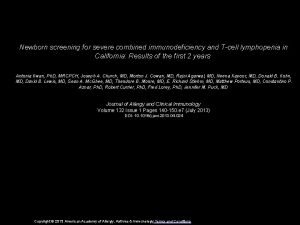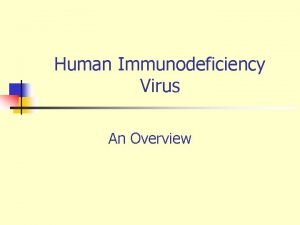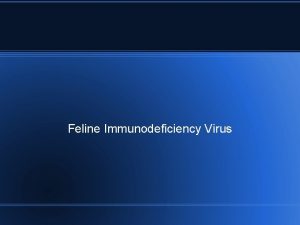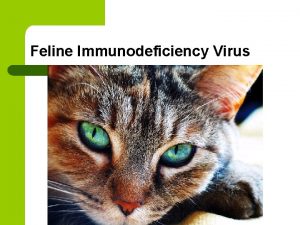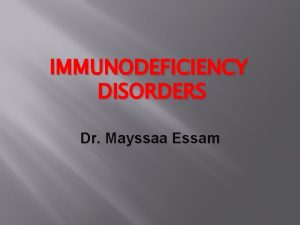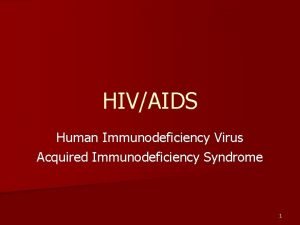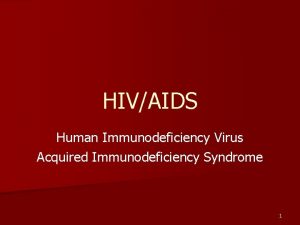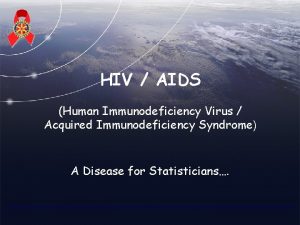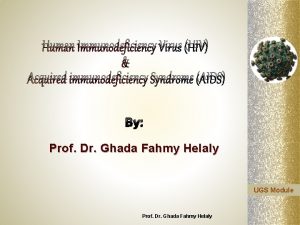Human Immunodeficiency Virus A virus that attacks cells










- Slides: 10

Human Immunodeficiency Virus A virus that attacks cells that help the body fight infection, making a person more vulnerable to other infections & diseases. ➔ If left untreated, HIV can lead to the disease of AIDS. ➔ Acquired Immunodeficiency Syndrome ➔ AIDS is the late stage of HIV infection that occurs when the body’s immune system is badly damaged because of the virus.

Stages of HIV ➔ When people with HIV don’t get treatment, they typically progress through 3 stages. ➔ HIV medicine can slow or prevent progression of the disease. ➔ Stage 1: Acute HIV Infection- Some people may get flu-like symptoms within a few weeks of acquiring HIV. Only an antibody test would detect a person HIV positive. ➔ Stage 2: Chronic HIV Infection- Asymptomatic stage; people feel & could look healthy for years but are still contagious. ➔ Stage 3: AIDS- Years of living with the virus damages the immune system leaving a person very weak & vulnerable to opportunistic infections which are life threatening

HIV is NOT transmitted through…. . ● ● ● Sneezing Kissing Mosquito Bites Tears Urine Hugging ● ● ● Sweat Sharing Drinks Earwax Saliva Holding Hands Coughing

Ways of Acquiring. . ❏ How do you get HIV ? ★ Roughly 36, 000 new infections yearly in the United States. ❏Blood ❏Semen & Sperm cell ★ Mainly spread by ❏Pre-seminal fluid unprotected sex. ❏Vaginial fluids ❏Rectal fluids ★ Secondly by sharing needles. ❏Breast milk

How do you get diagnosed with AIDS? T -cell count drops ★ Aids is a late stage of the infection when the immune below 200. system is badly damaged. Your Normally your T body has difficulty fighting off -cell count is about other diseases/infections. 1200.

HIV/AIDS 1. 2. 3. 4. 5. “Do Now” List a body fluid that does not contain/spread HIV? What does AIDS stand for? What pathogen is HIV? AIDS is diagnosed when the T-cell count hits what? Can a person still be contagious and not show any symptoms? 6. What is the most common way HIV spreads? 7. What exactly is HIV doing to the infected person’s body? 8. What is an opportunistic infection?

HIV statistics… HIV is the virus, AIDS is the condition. ★ About 14% are unaware they are HIV positive (1 in 7) ★ 1 in 4 new HIV infections is among youths between the ages 13 -24. ★ 45% of 13 -24 year olds with HIV are unaware. ★ Most affected: Men ★ Roughly 16, 000 people die a year from an HIV/AIDS.

Understanding an HIV/AIDS treatment HIV medications can help lower your viral load, fight infections, and improve your quality of life. They can lower your chances of transmitting HIV, but if you take them incorrectly, you can still give HIV to others. They're not a cure for HIV, nor are they a vaccine.

Abstinence HIV Prevention Properly using male condoms Not sharing or reusing needles Pr. EP (pre-exposure prophylaxis) is medicine people at risk for HIV take to prevent getting HIV from sex or injection drug use. PEP (post-exposure prophylaxis) means taking medicine to prevent HIV after a possible exposure. PEP should be used only in emergency situations and must be started within 72 hours after a recent possible exposure to HIV.

HIV Testing ➔ Lab Tests (Nucleic Acid Test) require blood to be drawn and sent to a lab. ● The results may take several days to be available. ● Looks for the virus in the blood, but an expensive test! ➔ Rapid antibody screening test, usually done with blood from a finger prick or with oral fluid, results are ready in 30 minutes or less. ➔ Oral fluid antibody self-test provides results within 20 minutes. ➔ Where to get tested locally https: //gettested. cdc. gov/

